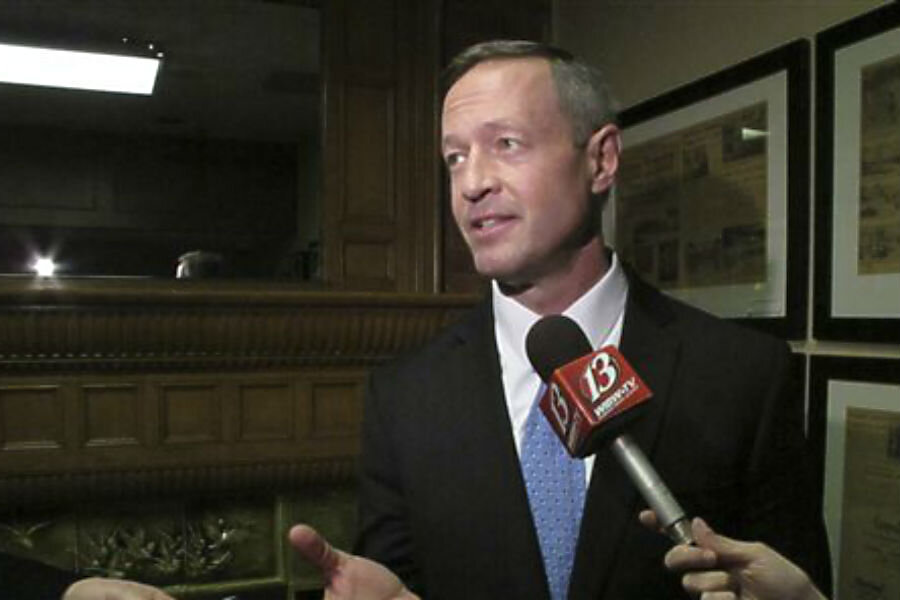Baltimore violence and Martin O'Malley's mayoral legacy
Loading...
| Baltimore
Martin O'Malley often casts Baltimore as the comeback city that overcame the ravages of drugs and violence when he was mayor.
Now, weeks before the former Maryland governor expects to enter the 2016 presidential race and challenge Hillary Rodham Clinton in the Democratic primaries, Baltimore's turnaround has been marred by the unrest after the police-custody death of Freddie Gray. The turmoil has placed new scrutiny on O'Malley's "zero tolerance" law enforcement policies as mayor from 1999 to 2006.
The record shows that murders and violent crime overall declined in O'Malley's years as mayor. But in that time, a grand jury concluded that too many arrests were being made in black neighborhoods without merit. And the city settled a lawsuit from people who said they were wrongly arrested for minor offenses. Altogether, these are the sort of concerns driving some of the anger in Baltimore today.
David Rocah, a staff attorney with the ACLU of Maryland, said the O'Malley administration left a legacy of "hyperaggressive and militarized policing" that, in his view, contributed to the outrage behind the riots. "I think the idea that you can arrest your way to public safety has always been deeply misguided and counterproductive," Rocah said.
But O'Malley says those judging him in hindsight should remember the crime and despair of the Baltimore he inherited as mayor.
"I don't think that any of us want to go back to the days of 1999," O'Malley said. "Our city is undoubtedly a safer place, and our city is becoming a better place, but our city still has a lot of progress to make."
He spoke outside the Dawson Safe Haven Center, an after-school refuge for children that was once a home for a family of seven killed in a 2002 firebombing by a drug dealer. O'Malley called that episode "our Alamo."
Even now, O'Malley clings to the story of Baltimore's redemption, terming the unrest "a heartbreaking setback for an otherwise remarkable comeback."
He said Sunday on NBC's "Meet the Press" that when he makes an announcement about his presidential intentions, he wouldn't think of making it anywhere other than Baltimore.
O'Malley has tried to build a following in Iowa and New Hampshire as an alternative to Clinton, the dominant front-runner. O'Malley has backed tougher regulations on Wall Street, opposed the Trans-Pacific Partnership trade deal and addressed student debt — issues that resonate with liberals.
Still relatively unknown, even among Democrats, O'Malley frequently points to his time as mayor as a key part of his biography.
A 2013 video by his team, shown at a New Hampshire Democratic dinner where he appeared, described Baltimore in the late 1990s as a "cauldron of crime, drugs and profound despair" and credited O'Malley with "an assault on hopelessness. He didn't make a campaign promise to make the city safer, he made a pledge. And he kept it."
In the 1990s, more than 300 people were murdered each year in Baltimore. O'Malley advocated "stop-and-frisk" practices, cracked down on lower-level crimes such as public drunkenness and disorderly conduct, and brought in two police commanders from New York steeped in such policing. The number of homicides fell to 253 in 2002 and stayed below 300 during his two terms, while never dropping to his goal of 175.
But the approach did lead to many arrests.
In 2005, a Baltimore grand jury found excessive arrests in black neighborhoods and recommended retraining officers. Judge Joseph McCurdy Jr. had tasked the panel with determining "what can be done to address the lack of confidence that exists between many members of the public and law enforcement."
The ACLU and the NAACP sued in 2006 on behalf of 14 plaintiffs who said they were wrongly arrested as part of a policy that emphasized arrests for minor offenses under O'Malley's watch. The city agreed to the $870,000 settlement in 2010.
O'Malley's successors moved away from zero-tolerance policing.
But he hasn't shied away from his record.
When the recent protests erupted, he cut short a trip in England and Ireland, returned to Baltimore and walked the streets to talk to former constituents and community leaders. Some stopped to shake hands or take pictures with him while others told him about their bad experiences with the police. A few heckled him.
O'Malley told one person the police were also victims of violence. "I buried 10 police officers" as mayor, he said. "Half were black. Half were white."
Asked about the zero-tolerance policy, O'Malley said, "What we had zero tolerance for was police misconduct. We worked at it every day."
On Sunday, he said that "extreme poverty breeds conditions for extreme violence."
His advisers note he created a civilian review board for police conduct, expanded drug treatment and saw a decline in excessive force complaints and police-involved shootings.
After two terms as mayor, he won two terms as governor with strong support in Baltimore.
"The people of Baltimore were given ample opportunities to express at the ballot box their satisfaction or dissatisfaction with the direction that our city took to reduce violent crime, to reduce homicides, to make our city more livable," O'Malley said.
Still, some think the riots erupted, in part, from years of frustration among residents who felt unfairly targeted.
"He had some responsibility," said Marvin "Doc" Cheatham, a former president of the NAACP's Baltimore city branch. "But you have to lay blame also with the majority of the City Council, because the majority of them were in office when he was in office."
___
Thomas reported from Washington. Associated Press writers Matthew Barakat and Lisa Lerer contributed to this report.
___
Follow Ken Thomas on Twitter at https://twitter.com.kthomasdc and Brian Witte at https://twitter.com/apbrianwitte





